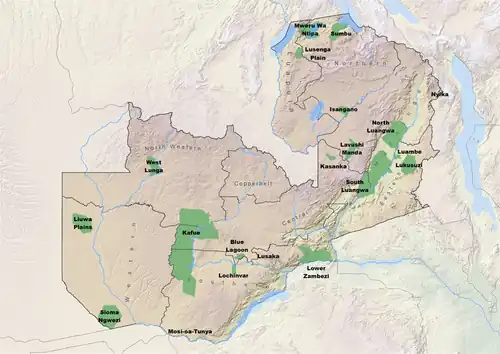List of national parks of Zambia
This is a list of national parks in Zambia. There are twenty national parks in Zambia, although many of them are not well maintained and so contain no facilities and few animals. Others have high concentrations of animals and are popular with tourists, while two or three are world-famous.
Map

Alphabetical list
- Blue Lagoon National Park — a small park in the north of the Kafue Flats west of Lusaka, known chiefly for bird life; one lodge
- Isangano National Park — east of the Bangweulu Swamps, no facilities, little wildlife
- Kafue National Park — world-famous for its animals, one of the world's largest national parks, several lodges
- Kasanka National Park — privately operated, south of the Bangweulu Swamps, one lodge
- Lavushi Manda National Park — south-east of the Bangweulu Swamps, no facilities, little wildlife
- Liuwa Plain National Park — in the remote far west, no facilities but some large herds of animals
- Lochinvar National Park — a small park south of the Kafue Flats world-famous for bird life and herds of lechwe, one lodge
- Lower Zambezi National Park — east of Lusaka, offers good wildlife viewing on the Zambezi River; numerous lodges[1]
- Luambe National Park — a small park, close to South Luangwa National Park, recovering after previous neglect, one new lodge
- Lukusuzi National Park — east of Luambe, undeveloped but with potential
- Lusaka National Park — opened in 2015, a small park on the south-east side of the capital city Lusaka[2]
- Lusenga Plain National Park — east of Lake Mweru, no facilities, no easy access, little wildlife
- Mosi-oa-Tunya National Park (Victoria Falls National Park) — the small park for Victoria Falls on the edge of the city of Livingstone (where accommodation is available), includes a small 'safari park'
- Mweru Wantipa National Park — no facilities, neglected, little wildlife but has potential for redevelopment
- North Luangwa National Park — this reserve has no facilities and is closed except to specially-licensed tours
- Nsumbu National Park (also known as Sumbu) — once ranked with Kafue and Luangwa, needs redevelopment but has good wildlife potential and offers lakeside game viewing, three lodges
- Nyika National Park — famous for its highland scenery and vegetation rather than wildlife; one lodge, but reached from the park of the same name in Malawi
- Sioma Ngwezi National Park — in the remote far south-west, no facilities but some large herds of animals
- South Luangwa National Park — world-famous as an icon of African wildlife, numerous lodges[3]
- West Lunga National Park — no facilities, no easy access, neglected, little wildlife but has potential for redevelopment.
Administration
The national parks are administered by the Dept of National Parks and Wildlife, an autonomous body responsible to the Ministry of Tourism, Environment and Natural Resources. This Authority took over from the former National Parks and Wildlife Service which suffered from chronic underfunding. Consequently of the 20 parks, five have never had management or facilities and have very little wildlife: Isangano, Lavushi Manda, Lusenga Plain, West Lunga, and Mweru Wantipa; three have substantial wildlife but have hitherto been left undeveloped as a matter of policy or because a neighbouring park has been favoured: North Luangwa, Luambe, and Lukusuzi; and three have wildlife but have been too remote to develop: Liuwa Plain, Sioma Ngwezi, and Nyika Plateau. Of the remainder, most are in quite good shape, except Nsumbu, which went through a decline due to a lack of transport infrastructure, and the zoological park section of Mosi-oa-Tunya National Park which needs rehabilitation.
In approximate order of importance in terms of wildlife resources, the eight main functioning parks, all with access and accommodation are:
See also
References
- "Lower Zambezi National Park". LowerZambezi.com. Lowerzambezi.com. Retrieved 10 July 2017.
- "Lusaka National Park opens with a bang". Zambia Daily Mail. Zambia Daily Mail. Retrieved 16 July 2015.
- "South Luangwa National Park". SouthLuangwa.com. SouthLuangwa.com. Retrieved 10 July 2017.